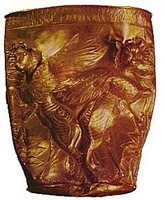Marlik Mounds Turned Into Paddy Fields

LONDON, 09 March 2006 (CAIS) -- While the historic mounds at Marlik, Gilan province, can be the site for further archaeological studies, farmers have turned the area into farmland and are engaged in cultivating crops. Expressing this, an Iranian archaeologist, Mohammad Reza Khalatbari told ISNA that excavations at Marlik cemetery was of significance given the fact that archaeological studies in Gilan province have entered a new phase.
Khalatbari, who is also director the excavation team at the historical site of Tool, Talesh city, Gilan province, recalled that the first team set up in 1960 with the aim of compiling the country’s archaeological atlas, selected Gilan province as the first subject for study.
The team directed by Mohsen Moqaddam conducted archaeological studies in Deilaman in the same province. Stating that Marlik Mounds earlier belonged to a person named Cheraqali, who was used to cultivate the land, he said following the identification of the mounds, two rounds of excavations in the area led to the discovery of valuable objects including admiralty-metal and golden items as well as potteries.
After the head of the team submitted his report, professor Ezzatollah Negahban, a US-based Iranian archaeologist, who was the technical deputy of the Archaeology Department in 1960, drew attention to the importance of the mounds and he himself directed the team.
During the excavations conducted by Negahban from 1961-1962, 53 graves belonging to the kings ruling the region and some other valuable objects were unearthed. The relics in Marlik belonged to kings who ruled the area in the second millennium BC and the early centuries of the first millennium BC were also discovered during this excavation.
During the most recent excavations the Kadusi Governmental Citadel was aslo discovered in the Marlik mound.

0 Comments:
Post a Comment
<< Home